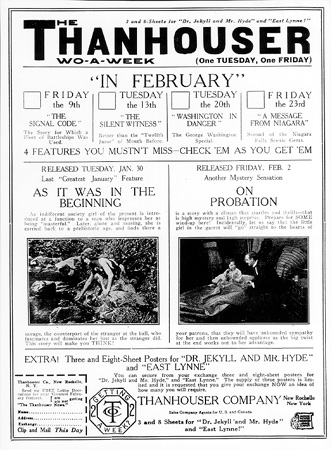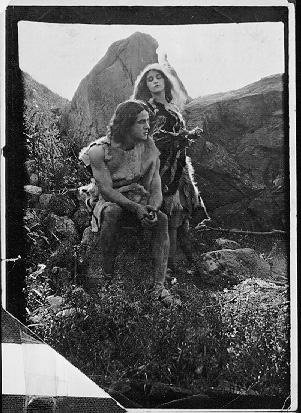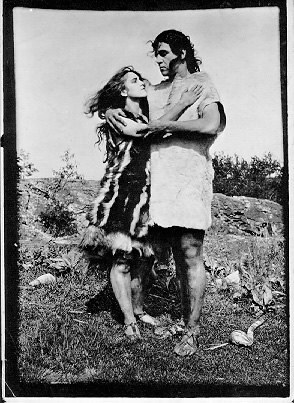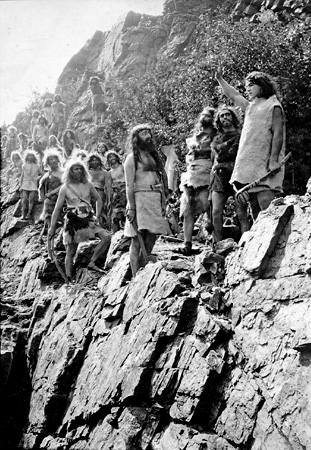 Volume II: Filmography
Volume II: Filmography Volume II: Filmography
Volume II: Filmography




Advertisement from The Moving picture World, January 27, 1912; production stills courtesy the Academy of Motion Picture Arts and Sciences. (F-240, F-250-1, F-250-2, F-251)
Working title: HER MASTER
January 30, 1912 (Tuesday)
Length: 1 reel
Character: Drama
Director: George O. Nichols
Cast: Mignon Anderson (heroine), Florence LaBadie
Locations: New Rochelle; Upstate New York
Note: The August 1912 issue of The Motion Picture Story Magazine noted: "We cannot, as a rule, tell where photoplays are made, but we believe that As It Was in the Beginning was made during the Thanhouser trip to Florida." This guess was probably wide of the mark, for Mignon Anderson did not go to Florida with the Thanhouserites in January. Moreover, The Arab's Bride, released on March 1, 1912, was billed by Thanhouser as its first Florida feature.
ADVERTISEMENT, The Moving Picture World, January 27, 1912:
"An indifferent society girl of the present is introduced at a function to a man who impresses her as being 'masterful.' Later, alone and musing, she is carried back to a prehistoric age, and finds there a savage, the counterpart of the stranger at the ball, who fascinates and dominates her just as the stranger did. This story will make you THINK!"
ARTICLE, The Moving Picture World, October 7, 1911:
"There will shortly be issued by the Thanhouser Company a remarkable film which has for its theme the illustration of the controlling power of a master mind. It opens with a ballroom scene in which a coquette is shown trifling with men's affections. They float around her like moths around a flame, seeking for a smile or some favor. She is evidently proud of her irresistible power. Finally one gentleman approaches and is introduced, but he is not smitten with her charms and turns away haughtily without a second glance. She is so upset by this unusual experience that she dreams of it at night and her dreams carry her back to the Stone Age when we see her as a haughty queen dethroned and shorn of her influence by the savage progenitor of the man who is destined to be her lord and master. The scenes depicting this part of the story are remarkably realistic, well acted, and of faultless photography. All together it is a pretty conception, a bold and successful departure from the usual thing - the kind of picture that your audience will talk about afterwards."
SYNOPSIS, The Moving Picture News, January 20, 1912:
"A society girl, admired and courted by many men, is still indifferent to one and all. She enjoys their company, is pleased with their attention, but has not met 'the' man, the one she would be willing to accept as a life partner. At a dance one evening there is introduced to her a man who could be best described by the one word, 'masterful.' He shows that he is attracted by the girl, but unlike her other suitors, he does not flatter her, or bow down before her. And his personality strangely affects her. With her thoughts all of the stranger, she sits alone, musing. It seems to her that she is carried backward many centuries to a time, when by her supposed magic arts, she reigned over a tribe of cave men, who worshipped her as a goddess. But in her rude court one day there appeared a stranger, who mocked at her pretensions and derided her powers. The others would have attacked him but she felt herself impelled to stay their hands, and the stranger walked off, still jeering at her.
"The stranger, not content with mocking at her, stirred up her heretofore loyal subjects to rebellion. They stormed her cave, but her magic was still potent and she drove them off, unarmed though she was. But the stranger remained, laughed at her and finally took her prisoner, dragging her back to the village of the men who had once held her as a queen. There the cave men consulted as to her fate, and enraged because they had so long believed in her magic power, decided to put her to death. The stranger, however, balked their plans. He regarded the girl with rude favor, told the others that she belonged to him, and ordered them out of his way. When they tried to bar his progress he fought his way through them and to safety in the wilderness outside with her in his arms. There they made their home, and the one-time goddess was content to fetch and carry for 'her man,' rough, brutal, and masterful though he was. For he was hers, and he protected her. She comes back to a realization of the present with a start. The stranger stands before her, and asks for the next dance. In a daze, she rises and takes his arm and walks with him toward the ballroom. And all the way the one thought is running through her head: 'I wonder if he is 'the' man?' For the stranger at the dance looked exactly like the man who in the prehistoric past subjugated the goddess and fought the timid cave men who first worshipped her and then wanted to put her to death."
REVIEW, The Moving Picture World, February 10, 1912:
"A very remarkable fantasy with a vitally suggestive picture of life among prehistoric men. The idea is not wholly original; but it is handled so very much better than any of the previous pictures, both as to the means used to express it and naturalness, that is, freedom of expression, that there is little choice even for our comparison. The picture opens at a dance. To the heroine (Miss Anderson), all men are but slaves; she treats them as she pleases. But one man meets her who is different. These scenes are good; but no one will feel like giving anything but the closest attention to the rest of it, which shows how it came about in far prehistoric days that all men but one were her slaves. It is the quality of these scenes that makes the picture a sure feature. It is of full length, well acted, set, conducted and well photographed."
Note: This is one of the earliest instances in which a reviewer in The Moving Picture World recognized a player other than Marie Eline.
REVIEW, The New York Dramatic Mirror, February 7, 1912:
"The purpose of this film is to show how the primeval forces still operate in man and woman, though restraint in civilization gives them different outward forms, and it proves itself in the nature of its presentation and exceptionally interesting psychological study. The belle of the occasion meets a man who has a peculiar fascination and power over her, and she retires to the conservatory, where she dreams of a prehistoric age when she was queen of a tribe of a primeval race whom she held in abeyance by her mystic power until a man in the likeness of this one appeared and showed the others that she was but a woman. He protected her from the others and took her away for himself, where she became his willing slave. The conception of primitive man is well carried out, and the picture as a whole creates a wonderfully good atmosphere and one of vivid impression."
# # #
Copyright © 1995 Q. David Bowers. All Rights Reserved.